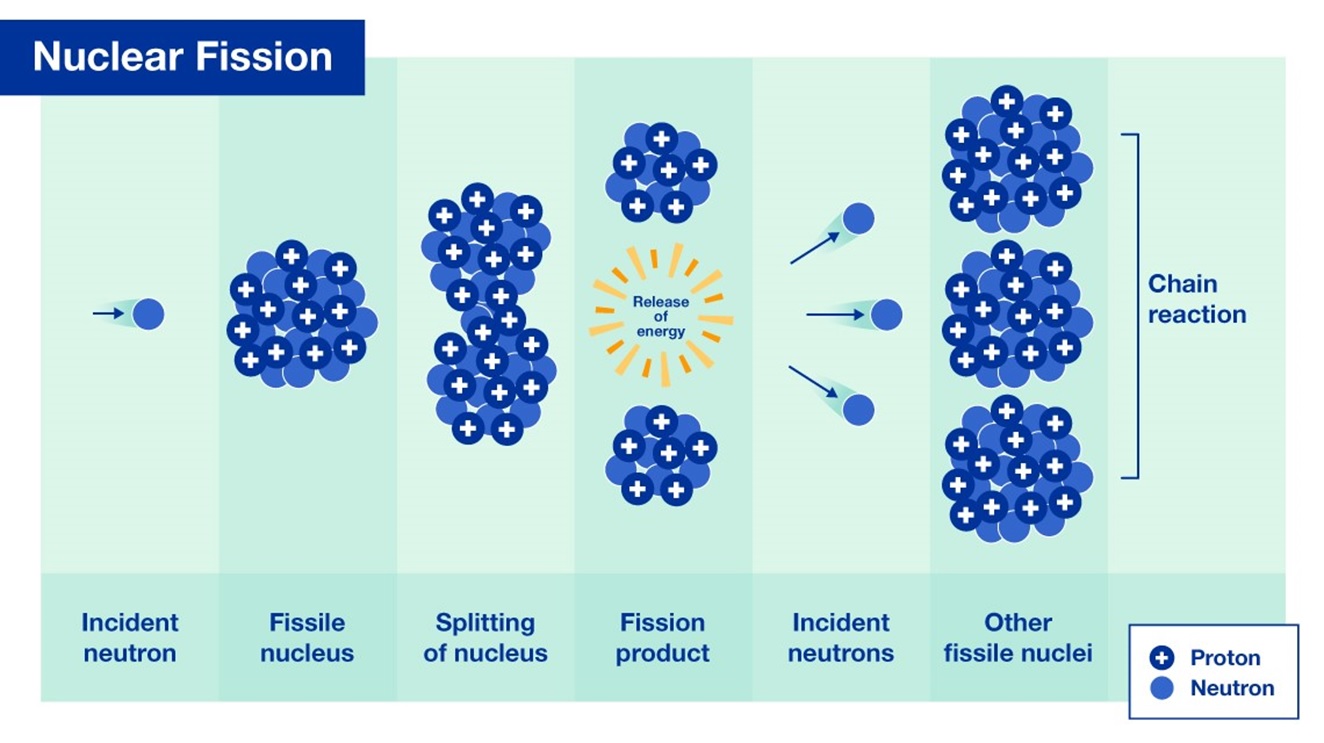What is Nuclear Fission
-
What is Fission? What is Nuclear Fission?
Fission is the action of dividing or splitting something into two or more parts.
Nuclear fission is a naturally occurring phenomenon during which an atomic nucleus is split into two or more parts. This is often accompanied by the emission of neutrons, charged fragments such as alpha particles, and energy in the form of gamma or X-rays.

Source: What is Nuclear Energy? The Science of Nuclear Power. The International Atomic Energy Agency
An example of material in nature that spontaneously undergoes nuclear fission is uranium-235, which is the main component of the nuclear fuel to be used in the proposed subcritical assembly.
When a neutron strikes a uranium atom in the fuel, the uranium atom splits, releasing more neutrons, energy, and other by-products.
In turn, the additional neutrons can strike and split other uranium atoms. This is the beginning of a "chain reaction" in which more and more uranium atoms are split, releasing more and more neutrons.
-
What is a Neutron? What is a Neutron Source?
A neutron is a tiny uncharged sub-atomic particle that is one component of almost all atoms. Neutrons are naturally occurring in the uranium fuel to be used in the subcritical assembly.
A neutron source is a device or material that emits radiation in the form of neutrons. Neutron sources are used in physics, engineering, medicine, petroleum exploration, biology, chemistry, and nuclear power.
-
What is a Chain Reaction?
A chain reaction occurs during nuclear fission when a neutron strikes an atom, which splits the atom to release more neutrons and energy, which neutrons may or may not strike another atom, which may or may not strike another atom....etc.
It is important to note that it is difficult to keep a chain reactor going. Most of the time, the neutrons don’t hit other atoms. Reactors work by controlling the physical process of nuclear fission: the process of splitting atoms to maintain a chain reaction.
-
What is Meant by Saying the Chain Reaction is "Critical" or "Subcritical"?
When the chain reaction is critical, it is the condition when enough neutrons are created to self-sustain the chain reaction. This is what happens in power generating reactors such as OPG and Bruce Power.
When the chain reaction is subcritical, it is the condition when not enough neutrons are created to sustain a chain reaction. As such, the reaction stops.
This is an inherent design feature of a subcritical assembly. Since the chain reaction is always subcritical, the reaction always stops.
-
How Does Nuclear Fission and Chain Reactions Work in a Subcritical Assembly?
In a subcritical assembly, there are not enough neutrons produced to keep the chain reaction going automatically or on its own. It is constantly in a negative state of reactivity, which means no meaningful energy is produced. An external neutron source is required to operate a subcritical assembly.
A subcritical assembly is considered "switched on" when a neutron source is actively inserted into the core. The neutron source naturally gives off neutrons which when inserted into the core, the subcritical assembly will “amplify” the concentration of neutrons through creating more fission chain reactions.
BUT the system is still always subcritical. Meaning to say – the neutron source and subcritical assembly allows for more chain reactions, but still not enough for the chain reaction to be critical.
When the neutron source is taken away, the system is considered “switched off” since all the chain reactions naturally stop.
Because a neutron source is required to be inserted, the system remains in a perpetual state of shutting down unless there is human interaction.
Simple to "switch on" and "switch off" is part of why a subcritical assembly is conducive for research, teaching, and training.
